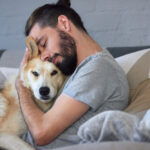Why Is My Dog So Clingy All Of A Sudden
Why Is My Dog So Clingy All of a Sudden?
Dogs are known for their loyalty, but sometimes they can become overly attached to their owners. If your dog has started following you around more than usual or whining when you leave, you may wonder why they are so clingy all of a sudden. In this article, we will explore some possible reasons for your dog’s behavior and suggest some ways to help them feel more secure.
Possible subtitles:
– Understanding Canine Attachment
– Separation Anxiety in Dogs
– Health Issues That Affect Behavior
– Changes in the Household Dynamics
– Training Tips for Reducing Clinginess
Understanding Canine Attachment
Dogs are social animals that have evolved to live in packs. In the wild, they would bond with their littermates and later with other members of the pack, including the alpha (dominant) dog. This bonding is based on mutual trust, cooperation, and communication through body language and vocalizations.
When dogs become domesticated, they transfer some of these instincts and behaviors to their human caregivers. They recognize us as part of their pack and seek our attention, protection, and guidance. However, not all dogs attach to humans in the same way or to the same degree. Some dogs are more independent and aloof, while others are more dependent and needy.
Factors that influence canine attachment include genetics, early experiences (such as socialization and training), breed tendencies (some breeds are bred for companionship), personality traits (dogs can have different temperaments), lifestyle (dogs that spend more time alone may be more prone to separation anxiety), and health status (some medical conditions can affect behavior).
Separation Anxiety in Dogs
One of the most common reasons why dogs become clingy all of a sudden is separation anxiety. This condition occurs when dogs feel distressed or panicked when left alone or separated from their owners. Signs of separation anxiety may include:
– Excessive barking, howling, or whining
– Destructive behavior (chewing, digging, scratching)
– House soiling (urination, defecation)
– Pacing or restlessness
– Refusal to eat or drink
– Self-injury (licking, biting, scratching)
Separation anxiety can be triggered by various factors, such as changes in routine (e.g. new job schedule), moving to a new home, the loss of a family member or pet, or traumatic events (such as a car accident). Dogs that are highly attached to their owners and have not been trained to cope with being alone may be more prone to separation anxiety.
To help your dog overcome separation anxiety, you may need to consult a professional dog trainer or behaviorist who can assess your dog’s individual needs and develop a customized plan. Some strategies that may help include:
– Gradual desensitization and counterconditioning (teaching your dog to associate being alone with positive experiences)
– Providing mental and physical stimulation when you are away (to distract your dog from feeling anxious)
– Using natural remedies or medication (under veterinary supervision) to reduce anxiety symptoms
– Creating a safe and comfortable environment for your dog (with toys, bedding, and access to food/water/toilet)
– Avoiding punishment or scolding for separation-related behaviors
Health Issues That Affect Behavior
Another possible reason why your dog is clingy all of a sudden is an underlying medical condition. Dogs cannot tell us when they feel unwell or uncomfortable, but their behavior can give us some clues. Some health issues that may affect behavior include:
– Pain or discomfort (from injuries, arthritis, dental problems, etc.)
– Hormonal imbalances (such as thyroid disorders or Cushing’s disease)
– Cognitive decline (as dogs age, they may develop dementia-like symptoms)
– Vision or hearing loss (which can make dogs more reliant on their owners)
– Digestive problems (such as food intolerances or allergies)
If you suspect that your dog’s clinginess is due to a health issue, you should take them to the vet for a thorough examination. Depending on the diagnosis, your vet may prescribe medication, dietary changes, or other treatments that can improve your dog’s quality of life.
Changes in the Household Dynamics
Dogs are sensitive creatures that can pick up on subtle changes in their environment. If there have been recent changes in your household dynamics, such as a new baby, a new pet, a new roommate, or a breakup/divorce, your dog may be reacting to these changes by seeking more attention from you. Dogs may also become clingy if they perceive that their owners are stressed, anxious, or depressed.
To help your dog adjust to changes in the household dynamics and reduce their clinginess, you can try:
– Maintaining a consistent routine (to provide predictability and stability)
– Giving your dog extra attention and affection (but not reinforcing clingy behavior)
– Encouraging your dog to interact with other family members or pets
– Using positive reinforcement training to reinforce desired behaviors
– Seeking professional counseling or therapy for yourself if necessary
Training Tips for Reducing Clinginess
While some degree of attachment between dogs and humans is desirable and natural, excessive clinginess can be problematic for both parties. If you want to reduce your dog’s clinginess without causing them distress, here are some training tips to consider:
– Teach your dog basic obedience commands such as sit, stay, come, and leave it. This will help them understand what you expect from them and build their confidence.
– Use positive reinforcement techniques such as treats, praise, and play to reward good behavior. Avoid using punishment or physical force as this can damage the bond between you and your dog.
– Gradually increase the duration and distance of your absences (e.g. start with leaving for a few minutes and gradually work up to longer periods). Pair each departure with a positive association such as giving your dog a treat or a puzzle toy.
– Create a designated “safe space” for your dog (such as a crate, a bed, or a room) where they can retreat when they feel anxious or overwhelmed. This will give them a sense of security and independence.
– Encourage your dog to engage in independent play or exploration (such as sniffing, fetching, or puzzle-solving) while you are present but not interacting with them. This will help them learn to self-soothe and enjoy their own company.
Conclusion
Dogs can be clingy for various reasons, ranging from attachment issues to health problems to changes in household dynamics. Understanding why your dog is clingy all of a sudden requires observation, empathy, and knowledge of canine behavior. By addressing the underlying causes of your dog’s clinginess and using training techniques that foster independence and confidence, you can help your dog become more balanced, happy, and secure. Remember that dogs are individuals with their own personalities and needs, so be patient, consistent, and flexible in your approach. And don’t forget to enjoy the unconditional love and companionship that dogs offer us every day!



